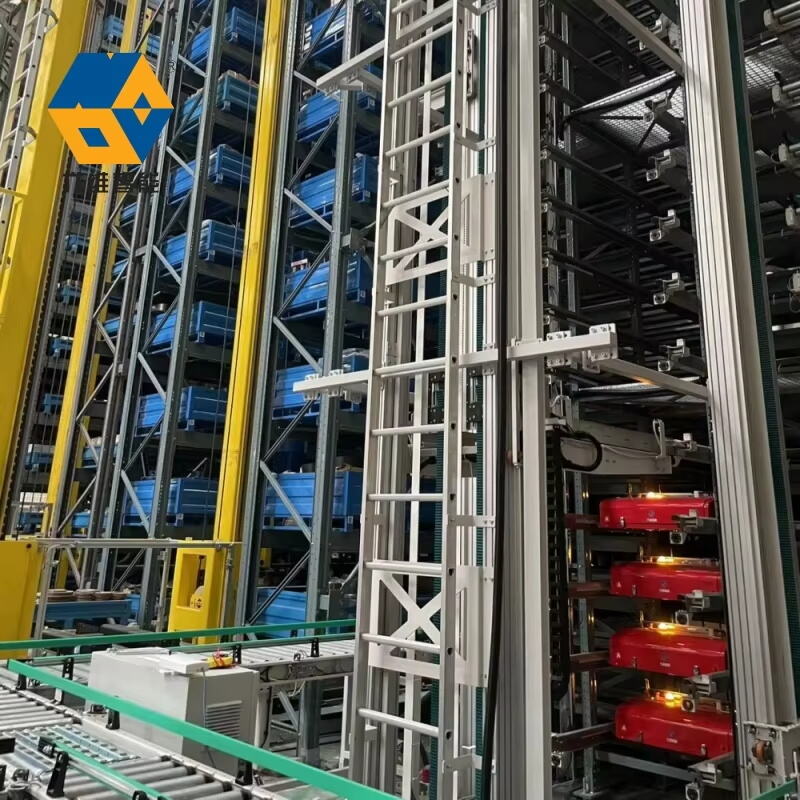Automated Storage and Retrieval Systems in E-Commerce Fulfillment
Accelerating Order Processing with AS/RS
AS/RS systems are changing how orders get processed through automated picking and placing of items. They cut down processing times dramatically, which makes them really valuable for companies dealing with the constant rush of online orders. Some industry reports show that when these systems are put into place, order processing speeds can jump by around 60%, showing just how much they boost efficiency. Since they require less hands-on work from employees, these systems help keep operations running smoothly while also cutting down on expenses. The automation allows businesses to redirect their efforts towards other important areas instead of getting bogged down with day-to-day tasks. This means companies stay flexible enough to handle whatever changes come along in the marketplace.
Reducing Inventory Errors in High-Demand Environments
AS/RS tech plays a big role in cutting down on inventory mistakes, particularly important for businesses dealing with fast moving goods. When people pick orders manually, mistakes happen all the time, which messes up inventory counts. Studies show warehouses that switch to AS/RS systems typically see error rates drop to around 1% or lower. That's pretty amazing when compared to traditional methods where errors can hit upwards of 15% sometimes. Another plus point for AS/RS is how it maintains better storage conditions throughout the facility, making inventory tracking much easier. The improved accuracy means fewer stockouts and happier customers overall. Companies using this technology tend to outperform competitors because they can fulfill orders faster and with fewer problems, giving them an edge in today's tight marketplaces.
Cold Chain Logistics Optimization
Temperature-Controlled Storage Solutions
The cold chain logistics system is really important when dealing with items that need specific temperatures, like perishable foods and medicines. These systems use special storage facilities to keep things at just the right temperature, which helps products last longer before going bad and keeps people safe when they consume them. Companies across different industries report better quality control after investing in proper temperature management. Spoilage rates drop quite a bit too. Beyond keeping products fresh, good temperature control actually helps the environment as well since less food ends up wasted. For businesses, this means saving money on replacements while doing something positive for planet Earth at the same time.
IoT Integration for Real-Time Monitoring
Bringing the Internet of Things into cold chain logistics gives businesses something really valuable: real time monitoring of what's happening inside transport containers. These smart systems keep an eye on temperature fluctuations and moisture levels throughout the entire shipping process. When problems start to appear, warehouse managers and logistics teams can jump in fast before expensive products get ruined or spoiled. Some numbers back this up too companies that have implemented IoT solutions report cutting down on wasted inventory by around 30 percent. That kind of waste reduction makes a big difference for bottom lines when dealing with things like fresh produce or temperature sensitive medications. Plus, having all this data at their fingertips means companies stay ahead of compliance requirements for food safety standards and drug transport regulations across different regions.
Automotive Manufacturing Efficiency
Just-in-Time Parts Management
The Just-in-Time (JIT) inventory system helps cut down on waste and brings down those pesky inventory costs because it matches part deliveries right up against actual manufacturing needs. With this setup, companies only keep what they really need on site at any given moment, which obviously cuts back on both storage expenses and wasted materials. Factories that get JIT right often see their inventory holding costs drop around 25% or so, and they still manage to keep production moving fast without slowdowns. For manufacturers dealing with tight margins, this means they can concentrate on getting products out the door efficiently instead of wrestling with warehouses full of stuff nobody wants right now.
Good parts management makes all the difference for keeping things running smoothly on automotive assembly lines. Just-In-Time (JIT) methods help avoid situations where too many parts pile up or there aren't enough when needed, which keeps the whole operation moving without unnecessary stops or slowdowns. When manufacturers incorporate JIT principles into their production systems, they can cut down on wasted space and resources while still being able to adjust quickly when customer demand changes unexpectedly. For instance, during peak seasons carmakers can ramp up production faster without tying up capital in excess inventory. The end result? Factories become much more flexible in their operations, saving money in the long run while maintaining high levels of output throughout different market conditions.
Heavy-Duty Component Retrieval
The introduction of heavy duty component retrieval systems is changing the game when it comes to managing big, bulky parts inside manufacturing plants. These specialized systems make handling massive components much easier, which cuts down on worker fatigue and makes the shop floor safer overall. The benefits go beyond just keeping employees happy though. When factories can get parts from storage faster, everything runs smoother. Some facilities report cutting retrieval times nearly in half, around 40% actually. This kind of improvement means assembly lines don't stall as much, production stays on schedule, and nobody has to waste time hunting for parts that should already be where they need to be.
Automated heavy duty retrieval systems in car manufacturing really step up game when it comes to getting things done faster and handling all those rush orders. When factories switch to these automated retrieval methods, they actually crank out more vehicles while still keeping quality standards intact and worker safety top priority. These systems cut down on mistakes made by humans and keep assembly lines running smoothly even when customer demands change overnight. For auto makers trying to stay ahead in this fast paced business world, having such efficient operations makes all the difference. Companies that invest in these technologies tend to outperform competitors who stick with older manual systems, especially as customer expectations continue to rise year after year.

Pharmaceutical and Healthcare Applications
Precision Handling of Sensitive Materials
Getting the handling right in pharmaceutical logistics matters a lot when dealing with sensitive stuff such as biologics and chemo drugs. These products need strict temperature control and careful handling throughout their journey to avoid breaking down or getting contaminated. Many companies have turned to automated systems as a way to get better at handling these delicate materials. Automated warehouses and smart storage solutions cut down on mistakes made by people, which means those life-saving medications stay safe during transport and proper storage. Some studies show that going automated cuts handling errors down by over 90 percent in certain cases, which obviously helps protect patients and keeps medicines working properly. Beyond just safety concerns, this kind of automation actually makes things run smoother across the whole medical supply chain too.
Regulatory Compliance in Medical Storage
Keeping up with strict rules like FDA guidelines and EU regulations is really important for anyone storing medical supplies. Automated systems actually work pretty well at handling all these complicated requirements. When facilities switch to automation, they find it much easier to track what's going on and report when needed, which helps them stay compliant and cuts down on problems caused by not following the rules. Some real world numbers back this up too - places that have gone automated see about 70 percent fewer issues related to compliance. The difference this makes shows just how helpful technology can be when trying to meet those tough standards while keeping everything safe and secure. Plus there's another benefit nobody talks about much: automation takes care of all the paperwork stuff so doctors and nurses can spend more time looking after patients instead of filling out forms all day long.
AI-Driven Predictive Analytics Integration
Demand Forecasting Accuracy Improvements
When companies start using AI for predictive analytics, they usually see better results in predicting what customers will want next. This helps them stay ahead of market changes and manage their stock smarter. The AI looks at old sales numbers and runs them through complex math formulas to spot trends people might miss when guessing manually. Some businesses report getting around 20% more accurate predictions after implementing these systems. With better forecasts comes smarter inventory control. Stores can keep enough products on hand to satisfy customers without tying up too much cash in excess stock sitting around unused. Better forecasting means fewer empty shelves and less wasted space filled with stuff no one wants right now. Retailers who got serious about AI forecasting found themselves able to respond faster to sudden spikes in demand during holiday seasons or unexpected drops when trends shift overnight.
Dynamic Workflow Adjustments
AI systems can really flex and change workflows as they go along when new data comes in, something old school methods just cant match. They keep an eye on what's happening in markets and inside company data all the time, so when there's a sudden spike in demand or some problem hits the supply chain, these smart systems react fast. Logistics teams find themselves keeping things running smoothly even when everything seems to fall apart around them. Take a look at companies that actually put AI to work managing their processes - many report about 30% better efficiency numbers after getting started. And it makes sense why folks want to adopt this tech. Faster order processing means happier customers, while smarter use of resources gives businesses that extra boost needed to stay ahead in tough markets.
Sustainable Logistics Advancements
Energy-Efficient Warehouse Design
Designing warehouses to save energy makes good business sense while cutting down on environmental damage too. Warehouses that install solar panels and upgrade to better lighting systems often see their energy bills drop by about half. Take LED lights for example they consume way less power than traditional bulbs. Many facilities are also adding smart controls that automatically adjust lighting based on activity levels. Going green isn't just good PR these days either. Companies need to meet tougher regulations around carbon output anyway. So investing in efficient designs helps businesses stay compliant while saving money long term. The bottom line is warehouses that focus on energy efficiency end up being both environmentally responsible and financially savvy operations.
Space Utilization Maximization Strategies
Getting the most out of available space inside warehouses really matters when it comes to running things efficiently and cutting costs. When companies install smart storage options such as Automated Storage and Retrieval Systems (ASRS) or simply rearrange how their warehouses are laid out, they often see around 40 percent better use of space. What these systems do basically is make good use of vertical areas so that businesses can fit far more products into the same amount of floor space. This helps keep inventory moving faster while making day to day operations run smoother throughout the facility. Better organized spaces mean workers spend less time searching for items, which translates into faster order processing times and ultimately boosts overall productivity across the board.
FAQ Section
What are Automated Storage and Retrieval Systems (AS/RS)?
Automated Storage and Retrieval Systems (AS/RS) are advanced technologies that automate the storage and retrieval of goods in warehouses, improving efficiency and reducing manual labor.
How does IoT improve cold chain logistics?
IoT enhances cold chain logistics by enabling real-time monitoring of key environmental factors such as temperature and humidity, reducing spoilage and waste.
What is Just-in-Time Parts Management?
Just-in-Time Parts Management is an inventory strategy that aligns the delivery of components with production schedules to minimize storage costs and waste.
Why is Ai-driven predictive analytics important in logistics?
AI-driven predictive analytics provide improved accuracy in demand forecasting and dynamic workflow adjustments, leading to better inventory management and operational efficiency.

